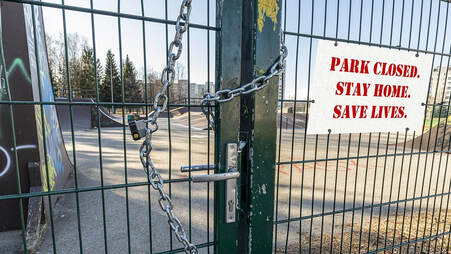 Stay at Home Stay at Home There is a tsunami of misinformation being circulated about COVID-19, and many science communicators are trying to counter this with facts. I have already explained, for example, that COVID-19 is not like the flu, and the perils of ignoring this have already been exposed by the situation of Brazil whose president, Jair Bolsonaro, considers COVID-19 to be “a little flu”, and has done his best to undermine the efforts at mitigation by cities and states in his country. As a result of this, Brazil's COVID-19 cases have jumped to second place in the world after the United States. Another misinformation that is being circulated in social media is the notion that all the mitigation measures against COVID-19, from masks and social distancing to the stay at home orders, did not work to contain the spread of COVID-19. This can be demonstrated not to be true. There is abundant evidence that mitigation against COVID-19 reduced its spread both in the United States (for example: 1, 2, 3, 4, 5, 6, 7, and 8) and in other countries (1, 2, 3). There also is evidence from the past that these measures work. Even if you are not a scientist, it’s not difficult to figure out that a virus will spread more slowly in a population whose members interact less with each other compared to a population whose members interact more. This is really a no-brainer. Mitigation measures have prevented the health care system from being swamped with hospitalizations (what is known as “flattening the curve” of viral spread) as happened in populous localities that did not implement these measures soon enough. You have all read the stories and seen the pictures and videos of what uncontrolled spread of COVID-19 can do. I don’t need to belabor this point. But there are other important things that we have gained with mitigation that are not often mentioned.
There is a vast world-wide network of hundreds of thousands of scientists that has been working around the clock during the pandemic in hospitals, universities, companies, and other organizations investigating the virus, how it spreads, and meticulously analyzing the symptoms of the patients presenting with the disease. These scientists share findings, information, ideas, and experience, and test old and new treatments on cultured cells, animals, and humans. It is thanks to the action of these scientists that we now have a more accurate picture of the symptoms of COVID-19 and effective strategies to minimize the spread of the virus as we rescind stay-at-home orders and begin reopening our society. These scientists are also developing vaccines against COVID-19 and dealing with some unique problems in vaccine development pertinent to coronaviruses, and they are conducting studies to evaluate the benefit of other potential treatments for COVID-19. All in all, there are currently more than a thousand clinical trials all over the world investigating treatments for COVID-19. In these studies, some treatments that were initially touted as game changers such as hydroxychloroquine have so far not lived up to their initial promise. But other studies have shown more promise, such as that of the antiviral compound remdesivir, which is part of a remarkable story involving two decades of research into coronaviruses. One of the greatest achievements of scientists studying COVID-19 is a reevaluation of what the disease really is. The virus that causes COVID-19 is called “SARS-Cov-2”. This stands for “severe acute respiratory syndrome coronavirus 2”. This is because it was thought that the virus would predominantly infect the airways. But early in the pandemic, doctors in China treating COVID-19 patients made the observation that hospitalized patients were experiencing blood clots. Bloodwork analysis indicated that the patients with the most severe illness were strongly positive for some of the most common indicators of risk of increased clotting. Doctors in other countries also found the same thing. A study with almost 3,000 patients found that indeed, those patients administered anticoagulants survived longer: an effect that was even more striking in the sickest patients. The International Society on Thrombosis and Haemostasis issued a document where they provided an interim guidance to treat patients with COVID-19 based on their coagulation parameters. This and other evidence ranging from the molecular to the clinical, has contributed to shape an emerging theory regarding COVID-19 which proposes that, although the disease starts in the lungs, the virus then proceeds to attack the blood vessels. This theory would explain many of the observations made regarding the particular symptoms of COVID-19, and suggests many new lines of treatment. Apart from flattening the curve and other considerations, by delaying the spread of the virus through mitigation we have gained time and knowledge, and during a pandemic these two things are invaluable. Image from pixabay by Queven is used under a pixabay license.
0 Comments
Your comment will be posted after it is approved.
Leave a Reply. |
Details
Categories
All
Archives
June 2024
|
 RSS Feed
RSS Feed